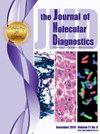Establishing a Variant Allele Frequency Cutoff for Manual Curation of Medical Exome Sequencing Data
IF 3.4
3区 医学
Q1 PATHOLOGY
引用次数: 0
Abstract
Medical exome sequencing pipelines consist of various preprocessing steps to prioritize credible causal variants before a pathologist or variant curation scientist manually interprets potential findings that are then reported to patients. The variant allele frequency (VAF), reported as the fraction of sequencing reads supporting a variant call, can be used to screen for technical artifacts, yet a specific filtering threshold has yet to be established. A total of 13,122 manually curated variants, sequenced from 289 patients using the Agilent SureSelect Focused Exome enrichment kit at the University of Kentucky Clinical Genomics laboratory from October 2019 to May 2023, were evaluated. Totals of 278 single-nucleotide polymorphisms (SNPs) and 3340 SNPs as technical artifacts are clinically reported. All reported variants had a VAF between 0.33 and 0.63, and 82% (2725/3340) of sequencing artifacts had a VAF of <0.33. It is proposed that removing SNPs in which the VAF is less than approximately 0.30 reduces manual curation time by approximately 20% while capturing all medically relevant variants in medical exome sequencing data sets.
为人工编辑医学外显子组测序数据设定变异等位基因频率临界值。
医学外显子组测序流水线包括各种预处理步骤,在病理学家或变异整理科学家人工解释潜在发现之前,优先考虑可信的因果变异,然后再报告给患者。变异等位基因频率(VAF)是指支持变异调用的测序读数的百分比,它可以筛选出技术伪影,但具体的筛选阈值尚未确定。我们评估了肯塔基大学临床基因组学实验室从 2019 年 10 月到 2023 年 5 月使用安捷伦 SureSelect 聚焦外显子组富集试剂盒从 289 名患者中测序的 13122 个人工策划的变异。我们在临床上报告了 278 个单核苷酸多态性 (SNP),以及 3,340 个作为技术伪影的 SNP。我们发现,所有报告的变异都有 0.33
本文章由计算机程序翻译,如有差异,请以英文原文为准。
求助全文
约1分钟内获得全文
求助全文
来源期刊
CiteScore
8.10
自引率
2.40%
发文量
143
审稿时长
43 days
期刊介绍:
The Journal of Molecular Diagnostics, the official publication of the Association for Molecular Pathology (AMP), co-owned by the American Society for Investigative Pathology (ASIP), seeks to publish high quality original papers on scientific advances in the translation and validation of molecular discoveries in medicine into the clinical diagnostic setting, and the description and application of technological advances in the field of molecular diagnostic medicine. The editors welcome for review articles that contain: novel discoveries or clinicopathologic correlations including studies in oncology, infectious diseases, inherited diseases, predisposition to disease, clinical informatics, or the description of polymorphisms linked to disease states or normal variations; the application of diagnostic methodologies in clinical trials; or the development of new or improved molecular methods which may be applied to diagnosis or monitoring of disease or disease predisposition.

 求助内容:
求助内容: 应助结果提醒方式:
应助结果提醒方式:


